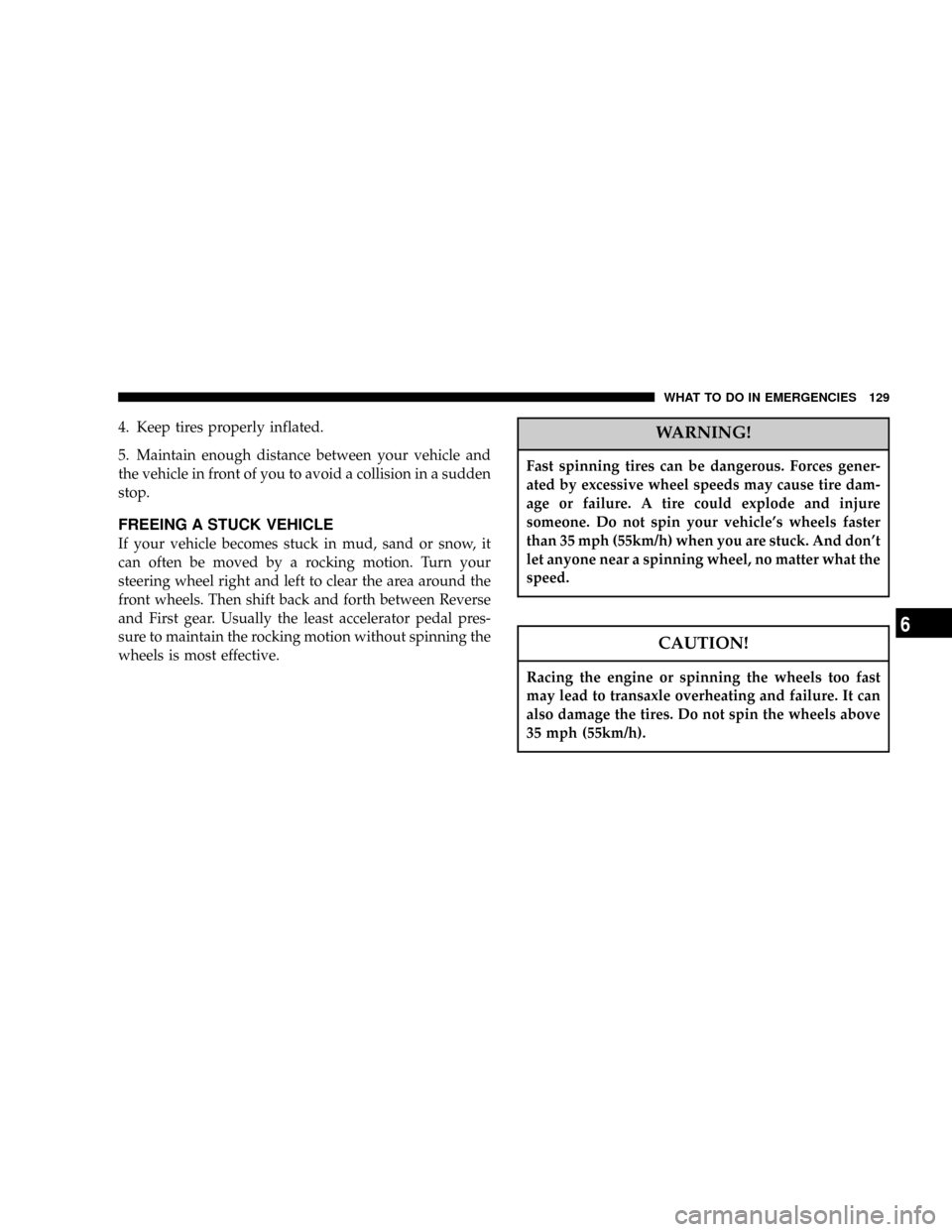2004 DODGE NEON SRT steering
[x] Cancel search: steeringPage 129 of 200

4. Keep tires properly inflated.
5. Maintain enough distance between your vehicle and
the vehicle in front of you to avoid a collision in a sudden
stop.
FREEING A STUCK VEHICLE
If your vehicle becomes stuck in mud, sand or snow, it
can often be moved by a rocking motion. Turn your
steering wheel right and left to clear the area around the
front wheels. Then shift back and forth between Reverse
and First gear. Usually the least accelerator pedal pres-
sure to maintain the rocking motion without spinning the
wheels is most effective.
WARNING!
Fast spinning tires can be dangerous. Forces gener-
ated by excessive wheel speeds may cause tire dam-
age or failure. A tire could explode and injure
someone. Do not spin your vehicle's wheels faster
than 35 mph (55km/h) when you are stuck. And don't
let anyone near a spinning wheel, no matter what the
speed.
CAUTION!
Racing the engine or spinning the wheels too fast
may lead to transaxle overheating and failure. It can
also damage the tires. Do not spin the wheels above
35 mph (55km/h).
WHAT TO DO IN EMERGENCIES 129
6
Page 130 of 200

TOWING A DISABLED VEHICLE
With Ignition Key
Your vehicle may be towed if the gearshift lever is in
NEUTRAL. If the transaxle is not operative, the vehicle
must be towed with the front wheels off the ground.
CAUTION!
If the vehicle being towed requires steering, the
ignition switch must be in the OFF position, not in
the LOCK or ACCESSORY positions.
If it is necessary to use the accessories while being towed
(wipers, defrosters, etc.), the key must be in the ON
position, not the ACCESSORY position. Make certain the
transaxle remains in NEUTRAL.
Without The Ignition Key
Special care must be taken when the vehicle is towed
with the ignition in the LOCK position. A dolly should be
used under the front wheels if the rear wheels are raised.
Proper towing equipment is necessary to prevent dam-
age to the vehicle.
Towing This Vehicle Behind Another Vehicle (Flat
Towing With All Four Wheels On The Ground)
Your vehicle may be towed at any legal highway speed,
for any distance, if the transaxle is in neutral.
130 WHAT TO DO IN EMERGENCIES
Page 131 of 200

MAINTAINING YOUR VEHICLE
CONTENTS
m2.4L Turbo Charged Engine Compartment....133
mOnboard Diagnostic System Ð OBD II......134
mEmissions Inspection And Maintenance
Programs
............................134
mReplacement Parts.....................136
mDealer Service........................136
mMaintenance Procedures.................136
NEngine Oil..........................137
NIgnition Wiring System.................142
NCrankcase Emission Control System........142
NFuel Filter..........................142
NAir Cleaner Element (Filter)..............142NMaintenance-Free Battery................142
NAir Conditioner......................144
NPower Steering Fluid Check..............145
NFront Suspension Ball Joints..............145
NBody Lubrication.....................145
NWindshield Wiper Blades................146
NWindshield Wiper Blade Replacement.......146
NWindshield Washer Aiming..............146
NWindshield Washer Reservoir.............147
NExhaust System......................147
NCooling System.......................148
7
Page 145 of 200

Power Steering Fluid Check
Checking the power steering fluid level at a defined
service interval is not required. The fluid should only be
checked if a leak is suspected, abnormal noises are
apparent, and/or the system is not functioning as antici-
pated. Coordinate inspection efforts through a certified
DaimlerChrysler Dealership.9
WARNING!
Fluid level should be checked on a level surface and
with the engine off to prevent injury from moving
parts and to insure accurate fluid level reading. Do
not overfill. Use only manufacturers recommended
power steering fluid.
If necessary, add fluid to restore to the proper indicated
level. With a clean cloth, wipe any spilled fluid from all
surfaces. Refer to Recommended Fluids, Lubricants, and
Genuine Parts for correct fluid types.
Front Suspension Ball Joints
There are two front suspension lower ball joints that are
permanently lubricated. Inspect these ball joints when-
ever under-vehicle service is done. Damaged seals
should be replaced to prevent leakage or grease contami-
nation.
Body Lubrication
Locks and all body pivot points, including such items as
seat tracks, doors, trunk and hood hinges, should be
lubricated periodically to assure quiet, easy operation
and to protect against rust and wear. Prior to the appli-
cation of any lubricant, the parts concerned should be
wiped clean to remove dust and grit; after lubricating
excess oil and grease should be removed. Particular
attention should also be given to hood latching compo-
nents to insure proper function. When performing other
underhood services, the hood latch, release mechanism
and safety catch should be cleaned and lubricated.
The external lock cylinders should be lubricated twice a
year, preferably in the fall and spring. Apply a small
amount of a high quality lubricant such as MopartLock
Cylinder Lubricant directly into the lock cylinder.
MAINTAINING YOUR VEHICLE 145
7
Page 153 of 200

Brake System
In order to assure brake system performance, all brake
system components should be inspected periodically.
Suggested service intervals can be found in the Mainte-
nance Section.
WARNING!
Riding the brakes can lead to brake failure and
possibly an accident. Driving with your foot resting
or riding on the brake pedal can result in abnormally
high brake temperatures, excessive lining wear, and
possible brake damage. You wouldn't have your full
braking capacity in an emergency.
Brake and Power Steering System Hoses
When servicing the vehicle for scheduled maintenance,
inspect surface of hoses and nylon tubing for evidence of
heat and mechanical damage. Hard and brittle rubber,
cracking, checking, tears, cuts, abrasions, and excessive
swelling suggest deterioration of the rubber. Particularattention should be made to examining those hose sur-
faces nearest to high heat sources, such as the exhaust
manifold.
Inspect all hose clamps and couplings to make sure they
are secure and no leaks are present.
Insure nylon tubing in these areas has not melted or
collapsed.
NOTE:Often, fluids such as oil, power steering fluid,
and brake fluid are used during assembly plant opera-
tions to ease the assembly of hoses to couplings. There-
fore, oil wetness at the hose-coupling area is not neces-
sarily an indication of leakage. Actual dripping of hot
fluid when systems are under pressure (during vehicle
operation) should be noted before hose is replaced based
on leakage.
NOTE:Inspection of brake hoses should be done
whenever the brake system is serviced and every engine
oil change.
MAINTAINING YOUR VEHICLE 153
7
Page 166 of 200

RECOMMENDED FLUIDS, LUBRICANTS AND GENUINE PARTS
Engine
Component Fluids, Lubricants and Genuine Parts
Engine Coolant MopartAntifreeze/Coolant 5 Year/100,000 Mile Formula HOAT (Hybrid Or-
ganic Additive Technology)
Engine Oil Use Mobil 1t10W30 synthetic engine oil.
Engine Oil Filter Mopar 4781452AA or equiv.
Spark Plugs Refer to the Vehicle Emission Control Information label in the engine com-
partment.
Fuel Selection 91 Octane.
Chassis
Component Fluids, Lubricants and Genuine Parts.
Manual Transmission Fluid MopartATF+4 Automatic Transmission Fluid.
Brake Master Cylinder MopartDOT 3 and SAE J1703 should be used. If DOT 3 brake fluid is not
available, then DOT 4 or DOT 4+ is acceptable. Use only recommended
brake fluids.
Power Steering Reservoir MopartATF+4 Automatic Transmission Fluid.
166 MAINTAINING YOUR VEHICLE
Page 196 of 200

Keyless Entry System..................... 16
Keys.................................. 9
Lane Change and Turn Signals.............. 64
Lap/Shoulder Belts...................... 20
Lead Free Gasoline...................... 113
Leaks, Fluid............................ 44
Light Bulbs........................162,163
Lighter, Cigar.......................... 58
Lights................................ 52
Airbag..........................35,44,65
Anti-Lock............................ 63
Brake Warning........................ 63
Center Mounted Stop.................. 164
Daytime Running...................... 54
Dimmer Switch, Headlight.............53,55
Dome............................... 53
Exterior Check........................ 44
Fog ................................ 54
Headlights On Reminder................ 54
High Beam Indicator................... 64
Instrument Cluster..................... 54
Lights On Reminder.................... 54Malfunction Indicator................... 66
Map Reading......................... 52
Oil Pressure.......................... 64
Park................................ 54
Passing............................. 55
Rear Servicing....................... 164
Rear Tail............................ 164
Seat Belt Reminder..................... 65
Side Marker......................... 164
Theft Alarm.......................... 65
Turn Signal.....................55,64,164
Voltage.............................. 65
Loading Vehicle........................ 117
Tires ............................... 100
Locks................................ 12
Child Protection....................... 14
Door............................... 12
Ignition............................ 134
Power Door.......................... 13
Steering Wheel........................ 12
Lubrication, Body....................... 145
Maintenance Free Battery................. 142
196 INDEX
Page 198 of 200

Power
Door Locks.......................... 13
Steering..........................95,145
Steering, Checking.................... 145
Windows............................ 19
Power Steering Fluid.................... 166
Pregnant Women and Seat Belts............. 26
Programming Transmitters................. 17
Radial Ply Tires........................ 107
Radio..............................68,69
Radio Broadcast Signals................... 68
Radio, Satellite.......................... 74
Rear Window Defroster................... 83
Reclining Front Seats..................... 49
Recommended Fluids, Lubricants and Genuine
Parts............................... 166
Reformulated Gasoline................... 114
Refrigerant............................ 144
Remote Keyless Entry.................... 16
Remote Trunk Release.................... 15
Replacement Bulbs...................... 162
Replacement Tires...................... 109Reporting Safety Defects................. 187
Rotation, Tires......................... 112
Safety Checks Inside Vehicle............... 43
Safety Checks Outside Vehicle.............. 44
Safety Information, Tire................... 96
Safety Tips............................. 43
Satellite Radio.......................... 74
Satellite Radio Antenna................... 76
Schedule, Maintenance................... 168
Seat Belts.............................. 19
Adjustable Upper Shoulder Anchorage...... 24
And Pregnant Women.................. 26
Child Restraint........................ 35
Extender............................ 27
Front Seat............................ 20
Maintenance......................... 160
Rear Seat............................ 20
Untwisting Procedure................... 25
Seats................................. 48
Adjustment.......................... 48
Rear Folding......................... 50
Reclining............................ 49
198 INDEX